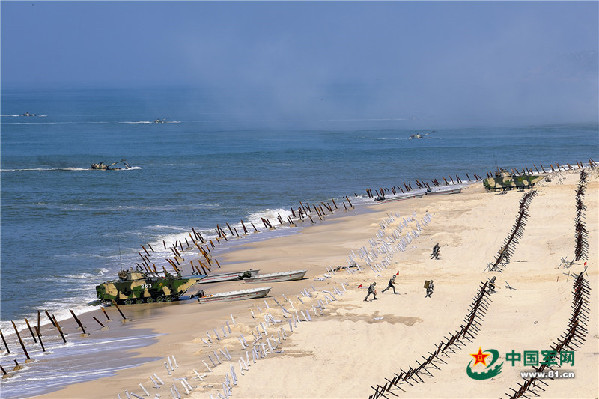
THE PENTAGON – The Chinese military is reorganizing its land forces, but its moves do not increase its ability to mount a large-scale beach assault across the Taiwan Strait, according to a new Department of Defense report.
Taiwan is the primary focus of amphibious assault and sea-based missile launch capability improvements made in 2018 by China’s People’s Liberation Army (PLA), the PLA Navy and PLA Marine Corps, according to the Pentagon’s Annual Report to Congress: Military and Security Developments Involving the People’s Republic of China.
“Taiwan persistently remains the PLA’s main ‘strategic direction,’ one of the geographic areas the leadership identifies as having strategic importance,” the report states.
The Chinese communist party seeks to diplomatically isolate Taiwan by stripping it of its diplomatic allies, by meddling in democratic elections and by applying economic pressure through redirecting tourism and financial development away from the island, Randall Shriver, assistant secretary of Defense for Indo-Pacific Affairs, said during a Friday media briefing about the report.
“China has never renounced the use of military force and continues to conduct military exercises,” Shriver said.
However, China does not appear to be currently investing in the equipment likely required for a direct assault on Taiwan, such as large amphibious assault ships and medium landing craft necessary for a large beach assault, according to the report. The bulk of China’s recently created marine corps forces currently lack proper equipment or operational training.
“There is also no indication China is significantly expanding its landing ship force at this time – suggesting a direct beach-assault operation requiring extensive lift is less likely in planning,” the report states.
Instead, China’s recent spate of military exercises and the PLA Navy’s focus on building large aircraft carriers, escort cruisers and amphibious transport dock (LPD) ships suggest the military, for now, is geared toward blue water naval operations and smaller expeditionary missions.
In 2018, the PLA Navy had five operational large Yuzhao-class (Type-071) amphibious transport docks, and three more were either under construction or being outfitted, according to the report. The first Rehnai-class guided-missile cruiser is expected to become operational later this year, carrying an array of long-range anti-ship cruise missiles, Shriver said.
“This cruiser class will be China’s premier carrier escort for blue water operations, carrying an array of long-range anti-ship cruise missiles,” Shriver said.
Meanwhile, the U.S. is monitoring China’s development of submarines capable of carrying ballistic missiles, Shriver said. China already can deliver ballistic missiles via ground-based launchers and from aircraft. Shriver wouldn’t say that China’s submarines now give the nation a nuclear triad. However, “they’re working toward having capable delivery systems in those three domains.”
The report also highlighted China’s increased interest in Arctic operations. China is building a new series of patrol boats designed to operate in the Arctic and has launched its second heavy icebreaker in 2018. Beijing maintains research stations in Iceland and Norway, according to the report.
“The report finds China continues to deploy tactics designed to fall short of armed conflicts and accomplish its objects and goals along its periphery in a so-called grey zone approach,” Shriver said.
A week ago, Senior Col. Ren Guoqiang, a spokesman for China’s Ministry of National Defense, discussed China’s activities in the South China Sea during a press briefing.
“China sticks to the path of peaceful development and adheres to a defense policy that is defensive in nature,” he said, according to an English translation of the briefing’s transcript released by the Ministry of National Defense.
“China will always be a builder of world peace, a contributor of world development and a protector of international order. We hope that some U.S. officials can see China and the PLA rationally and objectively, focus on the implementation of the consensuses reached between the two heads of state to develop bilateral and mil-to-mil relationship, and on maintaining global and regional peace and stability. This is what a responsible and faithful big country should do.”
In the South China Sea and Taiwan Strait, Shriver said much of China’s activities are designed to expand its influence over the region through military exercises, sea patrols and the placing of anti-ship missiles and jamming technology on islands in the region, Shriver said.
“I think those steps at militarizing those outposts are designed with a certain aim, and they seek to operationalize an illegal expansive sovereignty claim, basically inside the nine-dash line or the entire South China Sea,” Shriver said. “So, what we do about it is fly, sail, operate where international law allows. We’re increasingly joined by other countries, making that investment that the Chinese have made as insignificant as possible, particularly where their core goal is aimed at.”
U.S. Navy ships have sailed through the Taiwan Strait seven times since regular transits resumed in July 2018.
“The effect is the fundamental nature of the South China Sea hasn’t changed,” Shriver said. “China has changed some facts on the ground with respect to the land reclamation and the infrastructure on these outposts, but the effect that the Chinese seek, which is operationalizing this illegal expansive sovereignty claim, has not been achieved.”





